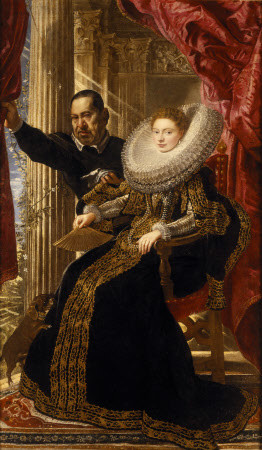
We need to talk about Charles I's "pet dwarf"
By Tom Shakespeare
Published on 22 March 2018
With a portrait of "The Queen's Dwarf" on display at the RA, Tom Shakespeare argues we need to look beyond the painting's spectacle to consider the person it's depicting – and the uncomfortable truths it still carries today.
Dwarfs were big (if you will excuse the pun) in the life of the 17th-century court, and an endless source of fascination for artists working in aristocratic circles. In the RA's current Charles I exhibition, there's Anthony van Dyck’s wonderful 1633 painting Henrietta Maria with Sir Jeffrey Hudson – a portrait of Charles I's queen and Jeffrey Hudson, known to his contemporaries as "The Queen's Dwarf".
Elsewhere, dwarfs have proved equally as alluring to other painters of the period: see Rubens’s rather sinister, almost grotesque 1607 painting, Marchesa Maria Grimaldi, and Her Dwarf – much less congenial to the modern eye than Van Dyck's portrait. Though neither picture – to me – matches the humanity of Diego Velázquez’s wonderful series of paintings of dwarfs at the court of Philip IV, such as Don Diego de Acedo (known as 'el Primo') from 1645 or Portrait of Sebastián de Morra of the same year – or indeed, Las Meninas itself. Other examples can be found earlier in the work of Mantegna and others, or later as with Niccolò Cassana’s 1707 painting of Angiola Biondi, a dwarf in the service of Violante Beatrice of Bavaria.

Henrietta Maria with Sir Jeffrey Hudson, 1633

Marchesa Maria Grimaldi and her Dwarf, c.1607

The Buffoon el Primo, 1644

Buffoon with books, c.1644

Las Meninas, 1656

Family and Court of Ludovico III Gonzaga: left-hand part,
Much like these other paintings, Van Dyck's portrait revels in the dwarf as a spectacle, prop or oddity – an attitude that still lingers when we look at the work more than 300 years after it was made. The language lingers too; we don't use the term "dwarf" much anymore, because it carries offensive connotations with circuses and freak shows, but it's proved a hard word to shake off. If he were around today, Jeffrey would be considered a person of restricted growth, or a person of short stature. Indeed, by harnessing all our accrued knowledge and understanding of disability, we can move beyond seeing Jeffrey as an aesthetic embellishment and appreciate him as a real person with an individual, extraordinary life.
In Van Dyck's portrait, Jeffrey is an elegant, childlike person of 14 years old, as much a pet as the monkey on his shoulder. His function in this painting is to be an object of curiosity, but also to make his Queen appear grander in comparison. Jeffrey appears to be a proportionate-stature dwarf, presumably caused by a growth hormone deficiency or another problem of the pituitary gland. Back then, of course, nobody understood hormones or genetics, and they were more likely to blame witchcraft, or sin.
A surprising amount is known about Jeffrey's life. Hudson senior was the custodian of the bulls kept by the Duke of Buckingham for baiting, and when his son was nine – still no more than 18 inches in height – he bestowed him to the Duchess of Buckingham. Later that year, when Charles I and Queen Henrietta Maria visited, Jeffrey made a surprise appearance concealed in a cold baked pie, and was presented to the delighted Queen as a gift. Her mother Marie de Medici, Queen of France, had a dwarf collection, so no doubt Henrietta was glad to have a dwarf of her very own.

Jeffrey Hudson and King Charles I, early 19th century

Jeffrey Hudson, early 19th century
Throughout the 1630s, Jeffrey duly played with the monkeys, the court giant, the married ladies and everyone else at court. He featured in many of Charles I’s notorious, elaborate, ostentatious Inigo Jones-designed court celebrations (known as masques) – sometimes performing a comic or grotesque routine and sometimes dancing in scenes with the monarchs. He was there as an entertainer after all; he had to earn his keep. Jeffrey was described as “wanting nothing but humility”, which makes me think he must have been insufferable, at least as a youth. But then, the joke was usually on him. Everyone was most amused that this little man came from England’s smallest county, Rutland, which has the motto "Multum in Parvo" – "much in little”.
Sir Jeffrey – as he became – went on to have adventures worthy of that phrase. He fought in the Civil War in 1642, ever after proud of his ‘Captain’ title. While in exile with his queen in Paris in 1644, he killed an average size man in a duel. For a 25-year-old of 3’9”, that’s a feat not far from Tyrion Lannister’s escapades. In the letters of Henrietta Maria, we read:
The gibing cavalier took no fire-arms, but merely a huge squirt, with which he meant at once to extinguish his small adversary, and the powder of his weapon. The vengeful dwarf, however, managed his good steed with sufficient address to avoid the shower aimed at himself and his loaded pistols, and, withal, to shoot his laughing adversary dead.
– which got Sir Jeffrey into trouble, because duelling was illegal in France, and because his victim was the brother of Lord Croft, a significant man of the court. Banished from France, he was captured by the Barbary pirates and consequently spent 25 years as a slave in North Africa. On the bright side, during this period he had a growth spurt to more than four foot, which must have been useful even if it made him rather less of a curiosity to the nobility.
When Charles II restored the monarchy in 1660, most of the North African slaves were redeemed. At this point, Jeffrey seems not to have rejoined the court, but instead retired to a thatched house in his birth town, Oakham, where a blue plaque can be seen to this day. Sir Jeffrey turned up in London in 1676, received mysterious payments from the Secret Service Fund in 1680 and 1681, and was then accused of being involved in a Catholic conspiracy – with a short spell in prison to show for it. Soon after his release in 1682, he died.
You will not meet a hypopituitary dwarf such as Jeffrey these days, because hormonal differences are easily treated by medicine. But there are still at least 5,000 people in Britain with other forms of restricted growth, most commonly the same achondroplasia that affected Sebastián de Morra (painted by Velázquez above) – characterised by an average sized torso and short limbs.
While their lives today may be less dictated by their bodies than Jeffrey’s was, people of restricted growth still face barriers achieving their full potential in the workplace. They are still subjected to violence and abuse. They are still mocked, assaulted, bullied, given roles in pantomimes and other entertainments, and generally disrespected.
If we want a future without discrimination against people of unusual embodiment, we must be prepared to look at our past as well as our present. Our treatment of people of restricted growth has been fuelled by (and produced) centuries of unexamined negative portrayals in media, comedy, art, theatre, film, cartoons – and even aristocratic portraiture. Today, such representations still prevent people from enjoying safe, valued lives full of opportunities to thrive.
As we stare at Jeffrey’s portrait in the RA's galleries, we must remember that we are still staring at people like him in 2018. Charles I's court may seem like a faraway frivolous fantasy, but its reduction of people to novelties and freaks is not so far away at all. To see the full picture, we cannot reduce Jeffrey Hudson to his legacy as "The Queen's Dwarf", but must see him in all his complexity – and indeed, glory.
Tom Shakespeare is Professor of Disability Research at the University of East Anglia, and a writer and broadcaster on disability and much more. He is also 4’5” tall.


